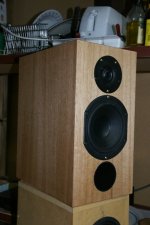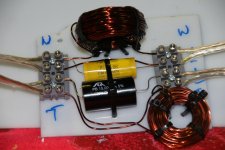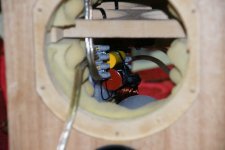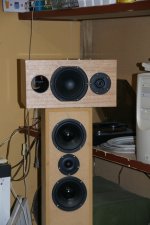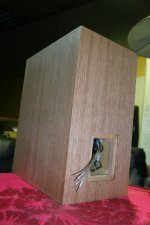Speedie the one thing people haven't asked you yet is how much bass you expect and want. just looking at the drivers T/S parameters would tell me that i would be disappointed with its bass performance if I was listening to any of my music. Are you trying to get a quart out of a pint glass ??
I'm guessing you really need a sub ( active of course ) or a set of three ways with a real woofer of two in th ebox
I'm guessing you really need a sub ( active of course ) or a set of three ways with a real woofer of two in th ebox
Moondog, subs would be the right way to go as you say, but it doesn't change the fact. The fs and Qts of my mains are not too far off speedie's, my calculated f3 is 65Hz. Without my subs I can detect the loss of extension, but warmth, fullness/weight and punch are all approximately right. I think this is a result of baffling, room placement, and getting the treble out of the way.
It can be as it all can, but inserting an equaliser can make lighter work of it. Play with it until it sounds natural, but if this seems impossible to achieve then it might be time to do some more moving or construction. At least at that point you'll have an indication of the band to focus on.
If the EQ works, then you should be able to incorporate the changes into the crossover.
If the EQ works, then you should be able to incorporate the changes into the crossover.
bass
allen and moondog
the bass that i expect is too my liking a punchy feel
not to say that i expect something that will shake my inards as my ears are flogged from the monsters of rock concert in 1986 england donnington park
now back to bass my old akia amp has 85 watts/ channel which incorparates some filters in the spectrum and treble and bass attenuation
if i put the treble to its miniumum and increase the bass to max include the loudness feature there is some bass to be heard
i would expect that if the boxes were used on a direct signal amp they would still lack what i like in bass
i dont want to have to pull my boxes down now as they are all glued and finished
as i stated in an earlier post i should build another set of boxes in plain MDF to the same specs then apply all of the suggestions that all of you helpfull people have put forward
dam this hobby what with working my own bussiness and being a full mash brewer there seems to be no time in the week to do what i should
i should retire then just play speaker building and brew to my hearts content
cheers to all speedie
ps i will try to post somemore photos if i can get them on the site as i have had trouble since my first photo posts
allen and moondog
the bass that i expect is too my liking a punchy feel
not to say that i expect something that will shake my inards as my ears are flogged from the monsters of rock concert in 1986 england donnington park
now back to bass my old akia amp has 85 watts/ channel which incorparates some filters in the spectrum and treble and bass attenuation
if i put the treble to its miniumum and increase the bass to max include the loudness feature there is some bass to be heard
i would expect that if the boxes were used on a direct signal amp they would still lack what i like in bass
i dont want to have to pull my boxes down now as they are all glued and finished
as i stated in an earlier post i should build another set of boxes in plain MDF to the same specs then apply all of the suggestions that all of you helpfull people have put forward
dam this hobby what with working my own bussiness and being a full mash brewer there seems to be no time in the week to do what i should
i should retire then just play speaker building and brew to my hearts content
cheers to all speedie
ps i will try to post somemore photos if i can get them on the site as i have had trouble since my first photo posts
Being a good home brewer myself I can attest to the fact that the hobbies are not totally exclusive of each other, sampling tho can give a higher than warranted level of satisfaction with the sound sometimes.
bass is usually cut/boosted at around 100/120 and the treble at around 1200/1500 so i think you really need to dial down the treble by 6 - 8 dB to start to even things out. or pick a different tweeter
bass is usually cut/boosted at around 100/120 and the treble at around 1200/1500 so i think you really need to dial down the treble by 6 - 8 dB to start to even things out. or pick a different tweeter
beer
dog 55
others that have listened to these puppies comment on the clean and clear sound that the tweeters produce
i personally think that they are a good purchase for the sound quality
the nomex drivers are given good wraps in this and other forums so it would appear that i may be the weakest link in the sound quality chain
i know that it is unreasonable to expect too much from a single 6 and a half inch driver but i am sure others have had better response from there projects
as a side note on sunday past my friends and i produced 1000 litres of APA on my friends new micro brewery
it was a hoot of an experiance
arhhh just love that idiot soup or music improver!
thanks again speedie
dog 55
others that have listened to these puppies comment on the clean and clear sound that the tweeters produce
i personally think that they are a good purchase for the sound quality
the nomex drivers are given good wraps in this and other forums so it would appear that i may be the weakest link in the sound quality chain
i know that it is unreasonable to expect too much from a single 6 and a half inch driver but i am sure others have had better response from there projects
as a side note on sunday past my friends and i produced 1000 litres of APA on my friends new micro brewery
it was a hoot of an experiance
arhhh just love that idiot soup or music improver!
thanks again speedie

hi speedie,
in my experience you can´t really rely on crossover calculations.
what i would do would be.
build a 18-20 liter box, put a 65-70mm vent in it. with a length around 20cm. but probaly you have to shorten it or give it more length after building the box. inside glue some 1cm granite tiles on the 19mm MDF, on top of the tiles you give some 1.5-3mm Bitumen plates. now your Enclosure should have around 18 liters for the woofer.
than you put something like that Needle and wool felt
then you have to get something like that:
http://www.amazon.de/Behringer-ECM8000-Kondensator-Messmikrophon/dp/B000HT4RSA
EDIROL UA-25 24 bit/96 kHz USB Audio Capture :: Overview
ARTA Home u can use it for free if you don`t want to save things.
and then measure.
make a target response and try to reach it with your components.
only my two cents. but working without measurements. hmmm, i don`t know. i don´t think it´s the easiest way to build a speaker. especially when you don´t know the driver and don´t know how they react on certain crossover values.
in my experience you can´t really rely on crossover calculations.
what i would do would be.
build a 18-20 liter box, put a 65-70mm vent in it. with a length around 20cm. but probaly you have to shorten it or give it more length after building the box. inside glue some 1cm granite tiles on the 19mm MDF, on top of the tiles you give some 1.5-3mm Bitumen plates. now your Enclosure should have around 18 liters for the woofer.
than you put something like that Needle and wool felt
An externally hosted image should be here but it was not working when we last tested it.
on the walls.then you have to get something like that:
http://www.amazon.de/Behringer-ECM8000-Kondensator-Messmikrophon/dp/B000HT4RSA
EDIROL UA-25 24 bit/96 kHz USB Audio Capture :: Overview
ARTA Home u can use it for free if you don`t want to save things.
and then measure.
make a target response and try to reach it with your components.
only my two cents. but working without measurements. hmmm, i don`t know. i don´t think it´s the easiest way to build a speaker. especially when you don´t know the driver and don´t know how they react on certain crossover values.
dog 55
others that have listened to these puppies comment on the clean and clear sound that the tweeters produce
:
Sure they may be all that and still be overpowering the mids, so the toal sound isn't the best, I often have a similar problem with the mids in OB 3-ways
photos
sorry for delay in posting more photos of project to date
i have had some health issues of late (pulminary embolism) blood clout in the lungs was from my vietnam holiday damn nearly killed me!
i hope that the crossover snaps will give some light on my requests
i todate have not removed any of the foam from the boxes
i own a toshiba satillite pro L650 lap top is the sound card in this unit ok for recording
do i need to purchase a cd with varing Hz tones to get these recordings or can it be achieved by playing music only
the BSC unit can be put into the circuit outside of the box as a test proceedure
many thanks speedie
sorry for delay in posting more photos of project to date
i have had some health issues of late (pulminary embolism) blood clout in the lungs was from my vietnam holiday damn nearly killed me!
i hope that the crossover snaps will give some light on my requests
i todate have not removed any of the foam from the boxes
i own a toshiba satillite pro L650 lap top is the sound card in this unit ok for recording
do i need to purchase a cd with varing Hz tones to get these recordings or can it be achieved by playing music only
the BSC unit can be put into the circuit outside of the box as a test proceedure
many thanks speedie
Attachments
The software you use should create test tones for you. For fixed measurements it should play each tone individually (but smoothly) over the space of a few seconds which is known as swept sine. Another more versatile approach uses all tones at once, with what's known as pink noise.
I suspect your compensation circuit will be unpredictable when used that way. So much so that you won't be able to evaluate it. Combining it with just the woofer circuit also needs careful consideration.
I suspect your compensation circuit will be unpredictable when used that way. So much so that you won't be able to evaluate it. Combining it with just the woofer circuit also needs careful consideration.
All information about woofers can be extracted using free software or indeed, without a computer. I guess it boils down to convenience. The only downsides I can see are the cost, and whether or not your data is going to be bound to the program somehow that restricts its usefulness.
I wasn't suggesting it could be done automatically, although someone else might happen to know of some free software that can. There's plenty of software that could extract the raw information for you to process, ie. recording yourself an impedance plot.
Of course it's important to know what you want to do and why. I, for example, typically use the manufacturers data when designing a closed box, as I don't normally think it is that critical although some people or in some situations may disagree.
Of course it's important to know what you want to do and why. I, for example, typically use the manufacturers data when designing a closed box, as I don't normally think it is that critical although some people or in some situations may disagree.
Hi Speedie, I've not used the WT2 but apparently it is nice and easy to use. I use speaker workshop for doing impedance measurements (you can also use it for measuring passive components such as coils and caps). A lot of people give up on speaker workshop though as it can be fiddly to get working properly.
The other nice thing about speaker workshop is that it's crossover simulation is very good (even if it is a bit clunky to use).
Certainly getting one of PE's calibrated mics (if it is the one that comes with its own unique cal file) might be a good option. I don't have a calibrated mic, which does sometimes give me some doubts, but I trust it since it is a mic that reportedly was very flat, and it measures very similarly to manufaturers data for my tweeters.
You can actually measure the impedance of your speakers with speaker workshop with no more than a bit of cable and some resistors. I don't even use an amp, I just measure the speaker directly driven by the sound card output. see Claudios speaker workshop cable page Cables The rest of claudio's page is worth looking at as well.
Also Jay's "unofficial speaker workshop manual" is available here: http://home.exetel.com.au/wintermute/diyAudio/sw_manual.zip
once you have a mic, I'd highly recommend using holmimpulse for doing the measurements.
Tony.
The other nice thing about speaker workshop is that it's crossover simulation is very good (even if it is a bit clunky to use).
Certainly getting one of PE's calibrated mics (if it is the one that comes with its own unique cal file) might be a good option. I don't have a calibrated mic, which does sometimes give me some doubts, but I trust it since it is a mic that reportedly was very flat, and it measures very similarly to manufaturers data for my tweeters.
You can actually measure the impedance of your speakers with speaker workshop with no more than a bit of cable and some resistors. I don't even use an amp, I just measure the speaker directly driven by the sound card output. see Claudios speaker workshop cable page Cables The rest of claudio's page is worth looking at as well.
Also Jay's "unofficial speaker workshop manual" is available here: http://home.exetel.com.au/wintermute/diyAudio/sw_manual.zip
once you have a mic, I'd highly recommend using holmimpulse for doing the measurements.
Tony.
I'm in a similar situation with the mic but just as you, I have a feel for it too. Where here do we go for a cal??
I like speaker workshop for its ability to manipulate plots, combine them, overlay them and export them, among other things. I've heard it can take measurements although I use Holm myself. The reason I use holm applies more to frequency response measurements than impedance measurements, for what it's worth.
I like speaker workshop for its ability to manipulate plots, combine them, overlay them and export them, among other things. I've heard it can take measurements although I use Holm myself. The reason I use holm applies more to frequency response measurements than impedance measurements, for what it's worth.
- Status
- This old topic is closed. If you want to reopen this topic, contact a moderator using the "Report Post" button.
- Home
- Loudspeakers
- Multi-Way
- disappointment
